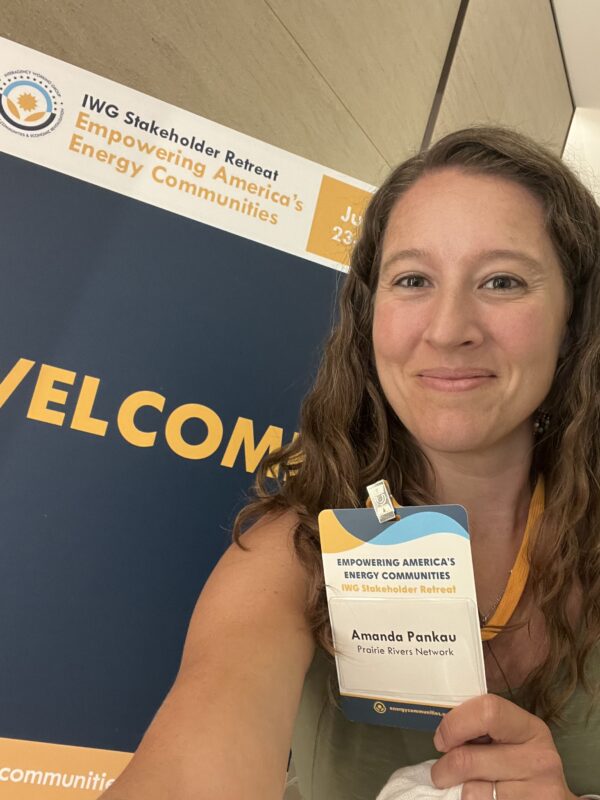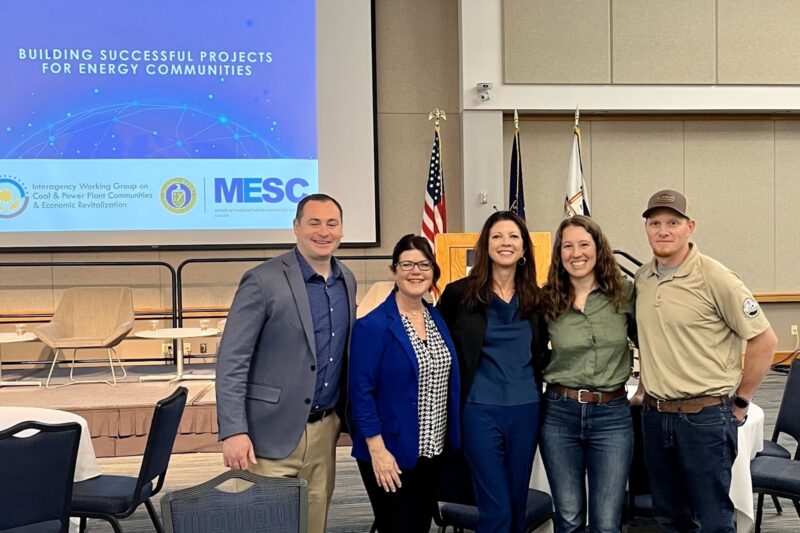The clean energy transition is well underway, as Prairie Rivers Network’s Amanda Pankau saw firsthand last week in Washington D.C.
Amanda, director of energy and community resiliency, attended the Empowering America’s Energy Communities Stakeholder Retreat, hosted by the Interagency Working Group on Coal and Power Plant Communities and Economic Revitalization (Energy Communities IWG).

Over the last three years, the Energy Communities IWG has made significant strides in partnering with and investing in energy communities to spur economic revitalization, remediate environmental degradation, and support workers.
This work is critical in the fight against climate change and a just and equitable transition to clean energy. At Prairie Rivers, we are working to proactively engage Illinois leaders with this work to capitalize on the opportunity to bring additional energy and environmental investments to Illinois.
Amanda was one of only two Illinois community stakeholders at the event. We want to ensure the information and lessons learned make it back to our Illinois energy communities and organizations.
You can read some highlights from the retreat below!
Highlight #1 – ANNOUNCEMENT of the Energy Communities AmeriCorps VISTA
The Energy Community AmeriCorps VISTA project was announced at the retreat. The program will serve low-income energy communities in the Illinois Coal Basin and eight other areas in the country that are experiencing energy transformations.
VISTA members will be placed with local organizations to help assess environmental impacts, identify existing supports, and develop economic transformation and revitalization goals with their communities. Learn more and apply here.
The program is also still looking for hosts. A host is a public or nonprofit organization in an energy community that provides workspace and supervision for VISTA members.
You can fill out the host interest form here.
Highlight #2 – Community Capacity is Limited but Technical Assistance is Available
A theme reiterated at the retreat was the lack of capacity of energy and rural communities to navigate the challenges of the energy transition and to apply for state and federal funding.
While there is still work to be done to build capacity in communities, there are technical assistance opportunities available to help including the following:
- The Energy Communities IWG has a “Navigator Team” ready to help communities navigate federal agencies and the opportunities they offer. You can fill out this form to request assistance from the team.
- The Just Transition Fund’s Federal Access Center provides technical assistance and funding to help secure federal funds for projects in coal regions. They really prioritize projects that create jobs or train people into new jobs. Southern Illinois is a target area for them.
- The Local Infrastructure Hub is a national program designed to connect cities and towns with the resources and expert advice they need to access federal infrastructure funding in order to drive local progress, improve communities, and deliver results for residents. The Hub hosts “bootcamps” for small- and mid-sized communities pursuing federal funding opportunities.
- The National Association of Counties has a Building Resilient Economies in Coal Communities initiative serves coal communities seeking to revitalize and diversify their economies.
- There are 16 Thriving Community Technical Assistance Centers across the country aimed at providing assistance to disadvantaged communities for energy and environmental projects. The two TCTACs serving Illinois include the Great Lakes TCTAC and the BIG EJ TCTAC.
Highlight #3 – Rapid Response Teams are Integral to the the Local Work of the Energy Communities IWG
The Energy Communities IWG has established “Rapid Response Teams” to carry out the work of the IWG at the community level.
At the retreat, a panel discussed the efforts of the RRTs in the Four Corners Region, Pennsylvania, and Wyoming. It was valuable to learn about the similarities and differences in each RRT and explore ideas to improve the work of the Illinois Basin RRT.
The Illinois Basin RRT was one of the first RRT’s established, serving the Illinois Coal Basin in downstate Illinois, southwestern Indiana, and western Kentucky. It is led by the USDA Rural Development in cooperation with other federal agency staff. The team has hosted several regional funding review meetings over the last year and a half aimed at connecting community leaders, organizations, and developers with resources and funding opportunities.
The next Illinois Basin RRT Funding Panel Meetings in Illinois are scheduled for:
- September 18, 2024, Litchfield, Illinois More details TBD
- October 22-23, 2024, University of Illinois Extension Center, Carmi, Illinois

Highlight #4 – Department of Energy has Updated Their Community Benefits Plans Resources
Department of Energy’s Kate Ringness shared updated and helpful information and resources related to Community Benefits Plans at the Retreat.
Community benefits are the positive contributions and improvements brought to the local community from a development project. These benefits can include economic, social, environmental, and infrastructural enhancements. They are usually negotiated between developers and community groups or local governments.
Community Benefit Plans (CBP) have gained recent attention because the Department of Energy is requiring a CBP for all applications for funding from the Bipartisan Infrastructure Law and Inflation Reduction Act.
DOE has updated their CBP templates on their website, providing more examples. We’ll share Kate’s Retreat slides here when they are available. Prairie Rivers Network has also created a Community Benefit Planning Fact Sheet.
Highlight #5 – Appalachian Communities are Forming Partnerships and Coalitions Across Coal Communities, Illinois’ Energy Communities Can Learn From Them
Appalachian communities and nonprofits have been building a narrative, power, and capacity around the energy transition in a way that Illinois could learn from.
In 2016 the Obama Administration’s Power Initiative invested 38.8M in energy communities, with funding going to 29 economic and workforce development projects– all in Appalachia. This investment in 2016 helped lay the foundation for continued partnerships and investments into the region that is evident by the turnout and success stories shared at events like the Retreat.
At the Retreat, Jacob Hannah, Executive Director of Coalfield Development shared the story of the Appalachian Climate Technology coalition (ACT Now). ACT Now received approximately $62.8 million from a Build Back Better Grant to spur job growth in 21 economically distressed and coal-impacted counties in southern West Virginia by creating a hub of clean energy and green economy jobs.
Highlight #6 – Energy Communities IWG Has a New Site Review Tool
The Energy Communities IWG has a new Site Review Tool, an interactive map providing access to publicly available information on facilities, nearby infrastructure, and community attributes, including energy community census tracts.
The Site Review Tool empowers community leaders and developers to promote investment into energy communities and encourages users to learn and explore the diverse range of investment options. This tool can be useful for applicants to identify relevant information about their project that is requested in U.S. Department of Energy (DOE) grant and tax credit submissions, including Qualifying Advanced Energy Project Credit (§ 48C) program energy community status and whether a project is located in a disadvantaged community.
Highlight #7 – Investments are Flowing to Energy Communities
The 2021 Bipartisan Infrastructure Law and the 2022 Inflation Reduction Act established tax credits and federal incentives to encourage private sector investment in energy communities. Between these incentives and the work of the Energy Communities IWG, the investments are flowing.
According to a 2023 report from the U.S. Department of the Treasury, “It is well-established that clean investments grew meaningfully after the [Inflation Reduction Act] passed. But we find that clean investments grew especially quickly in ‘Energy Communities,’ areas with a history of fossil fuel production, where clean industry potential exists but opportunity has been scarce.”
While many funding opportunities have passed, several are open now or are yet to be announced. The Energy Communities IWG maintains a funding clearinghouse to help communities navigate funding and tax credit opportunities.







